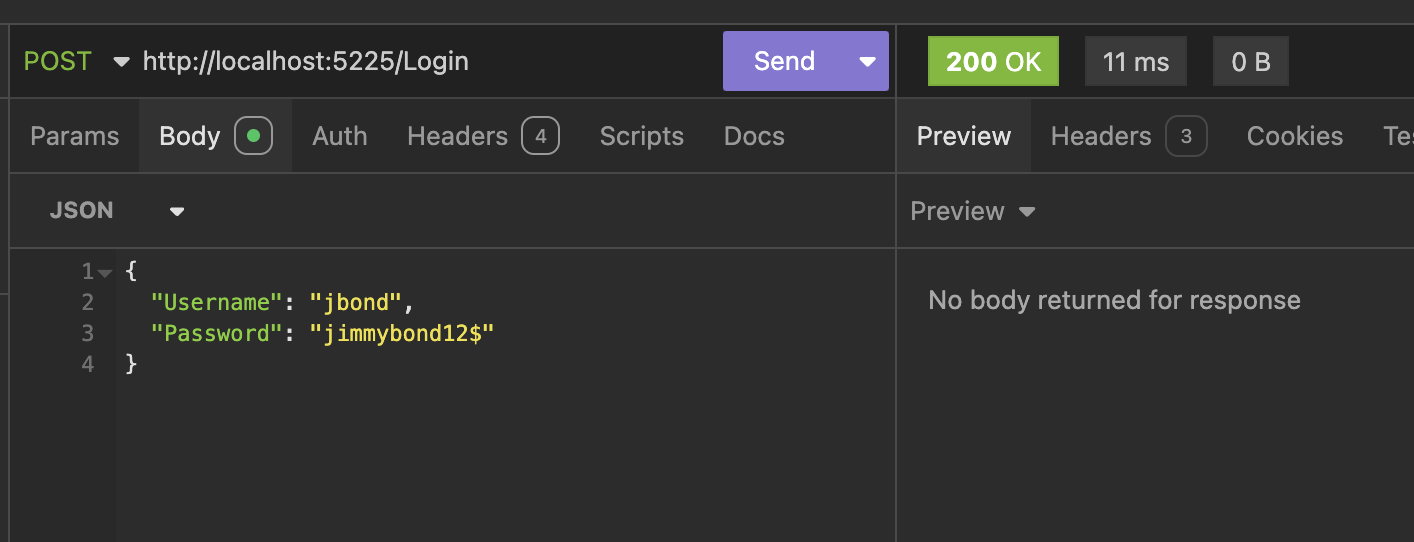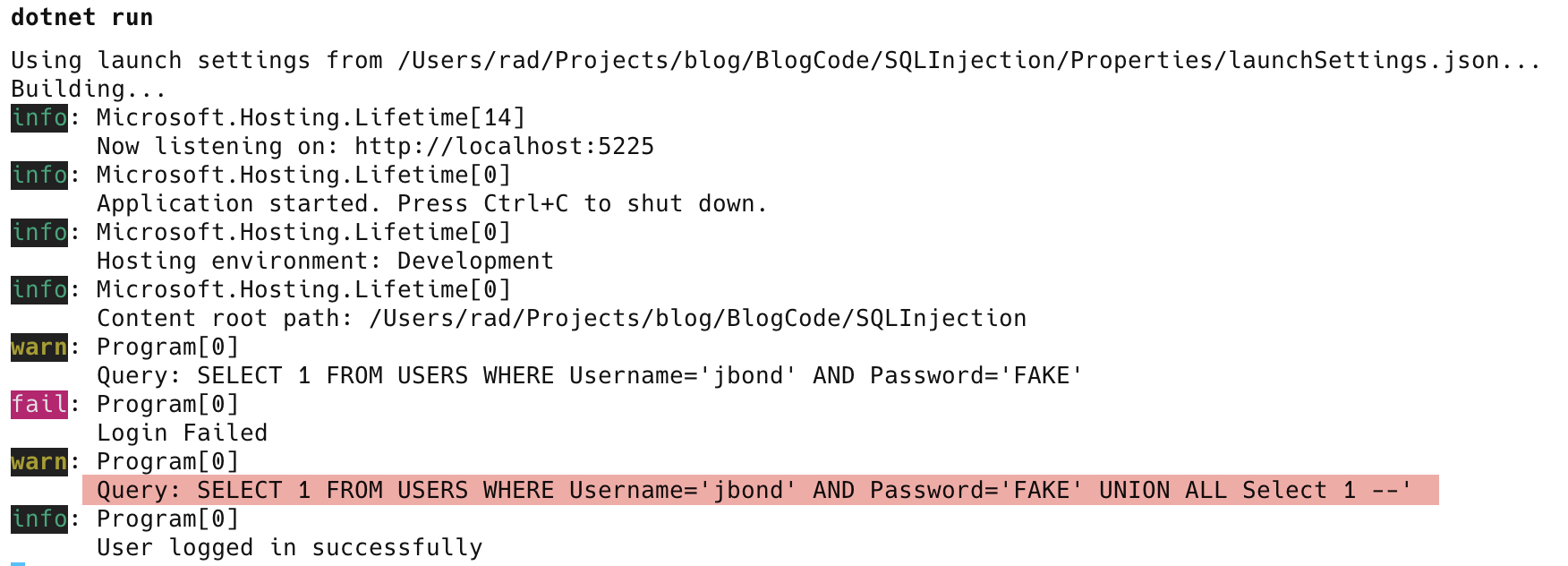How SQL Injection Works - Part 1
[Security, .NET, SQL]
This is Part 1 of a series on SQL injection.
You must be living under a very big rock, indeed, if you have not heard of SQL injection.
But what is SQL injection?
This post will explain using a simple example.
Assume we have a very simple application that provides an admin login.
This login requires a username and a password, after which the user is authenticated.
The users are stored in a table that looks like this:
| Column Name | Data Type | Description |
|---|---|---|
| UserID | Int | Primary Key |
| UserName | varchar(100) | User name |
| Password | varchar(100) | User password |
In our example, we will model this using a WebAPI and ADO.NET. This is to say, we are NOT using Entity Framework.
We first create the project:
dotnet new console -o SQLInjection
Next, we add the package for Sqlite support, Microsoft.Data.Sqlite. Sqlite is the database we will use for this example, but the principles will apply to any other database.
dotnet add package Microsoft.Data.Sqlite
THIS IS NOT HOW TO DO IT IN A PROPER APPLICATION. THIS IS JUST A DEMO
We will start by defining a simple type to store a login request.
public record LoginRequest(string Username, string Password);
Then, we will write a helper class with some methods to
- initialize our database schema (tables)
- Insert demo master data
public class Initializer
{
public const string ConnectionString = "data source=test.db";
public static void EnsureDatabaseExists()
{
const string initializeDatabase = """
CREATE TABLE IF NOT EXISTS USERS(UserID INTEGER PRIMARY KEY, Username VARCHAR(100), Password VARCHAR(100));
INSERT INTO USERS (UserID, Username,Password) VALUES (1, 'jbond','jimmybond12$');
""";
const string checkForTable = "SELECT COUNT(1) FROM sqlite_master WHERE type='table' AND name='USERS'";
// Create a connection object
using (var cn = new SqliteConnection(ConnectionString))
{
// Open the connection
cn.Open();
var cmd = cn.CreateCommand();
//
// Check if table exists
//
// Set the command text to our query defined above
cmd.CommandText = checkForTable;
// Execute the query and obtain the returned value
var returns = cmd.ExecuteScalar();
if (Convert.ToInt32(returns) == 0)
{
// Table does not exist. Initialize
// Set the command text to the query defined above
// to generate the database
cmd.CommandText = initializeDatabase;
// Execute the query
cmd.ExecuteNonQuery();
}
}
}
}
Finally, we will wire everything together and write an API endpoint to process login requests
using Microsoft.Data.Sqlite;
var builder = WebApplication.CreateBuilder(args);
// Setup DI to inject a Sqlite connection
builder.Services.AddSingleton<SqliteConnection>(_ => new SqliteConnection(Initializer.ConnectionString));
var app = builder.Build();
// Ensure our database is created and seeded
Initializer.EnsureDatabaseExists();
app.MapPost("/Login", (SqliteConnection cn, ILogger<Program> logger, LoginRequest request) =>
{
// Open a connection to the database from the injected connection
cn.Open();
// Create a command object from the connection
var cmd = cn.CreateCommand();
// Build the query that checks valid logins
var query = $"SELECT 1 FROM USERS WHERE Username='{request.Username}' AND Password='{request.Password}'";
// Log the query, so we can visualize it
logger.LogWarning("Query: {Query}", query);
// Set the command query text
cmd.CommandText = query;
// Execute the query
var status = Convert.ToInt32(cmd.ExecuteScalar());
// Check the returned number
if (status == 1)
{
// We are now logged in
logger.LogInformation("User logged in successfully");
return Results.Ok();
}
logger.LogError("Login Failed");
// Return a 401
return Results.Unauthorized();
});
app.Run();
A couple of things to note here:
- In our endpoint, we inject the SqliteConnection, a
LoginRequest, and anILogger. - We build a query to check that there is a result returned for a matching username (jbond) and password (jimmybond12$)
- If the username and password match, the user is authenticated
- If they do not, the user is unauthorized. Return an HTTP 401 response.
We can then go on to create and send two test responses using your favourite client.
My favourite is Insomnia.
Here we see a successful request in progress:

This is the equivalent in curl
curl --request POST \
--url http://localhost:5225/Login \
--header 'Content-Type: application/json' \
--header 'User-Agent: insomnia/10.3.1' \
--data '{
"Username": "jbond",
"Password": "jimmybond12$"
}'
Here, we see a failed request in progress.

This is the equivalent in curl
curl --request POST \
--url http://localhost:5225/Login \
--header 'Content-Type: application/json' \
--header 'User-Agent: insomnia/10.3.1' \
--data '{
"Username": "jbond",
"Password": "FAKE"
}'
If we look in the logs, we will see the query that got submitted to the database:

And it is here that the premise of SQL injection hinges.
Remember that the query is constructed at this point:

Given that the query is constructed using user-generated input, it is possible for an attacker to craft input so that the database receives a different query from what was intended for execution.
Instead of submitting FAKE, an attacker can submit the following:
FAKE' UNION ALL Select 1 --
If we submit this request with an invalid password, we are logged in!

How?
The answer is in the submitted query:

SELECT 1 FROM USERS WHERE Username='jbond' AND Password='FAKE' UNION ALL Select 1 --'
This is actually TWO queries:
SELECT 1 FROM USERS WHERE Username='jbond' AND Password='FAKE'
UNION ALL Select 1 --'
The first query will return no result as the condition is invalid.
The second query, however, returns a single value, 1, which the application is looking for as an indicator of a successful login.
Of interest is the second query has a section commented out: --'
This is because, remember, the entirety of this is what is meant to be the password:

Given the attacker has already provided a closing quote, the one that the application will provide will need to be commented out to ensure that the SQL submitted is valid.
Thus, with carefully crafted input, an attacker has breached this application.
At this point, you might ask what would happen if the application used a different technique to validate logins. Perhaps returning a count, checking for existence, or the many different ways to approach his problem. The attacker would probably not know which in advance.
That is a very valid observation.
Attackers have also addressed this. They build tools that send several carefully crafted payloads optimized for various scenarios with the probability that at least once would work. These attacks are usually automated, and one will be tried after another until one works, at which point the tool will signal to the attacker using logs or another such mechanism that a breach has been successful.
This technique is just as effective against other database engines - SQL Server, Oracle, PostgreSQL, MySQL, etc. It is just a matter of tweaking the input to accommodate each engine’s peculiarities.
In the next post, we will look at how to defend against this on the .NET platform.
TLDR
SQL Injection is the ability for attackers to craft a payload in such a manner that insecure applications submit to the database engine a totally different query than was intended by the developers.
The code is in my GitHub.
Happy hacking!